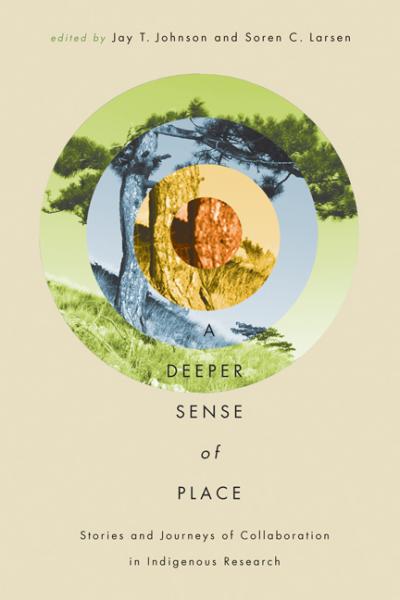Jay T. Johnson and Soren C. Larsen are the editors of A Deeper Sense of Place, released by OSU Press last fall, and the recent recipients of a collaborative fellowship from the American Council of Learned Societies to begin their next book project, being-together-in-place. Jay Johnson is also a recent recipient of the Association of American Geographers Enhancing Diversity Award.
On the blog, Johnson and Larsen use their own experience to reflect on the evolution and intricacy of collaborative research as a whole—and, like A Deeper Sense of Place itself, put academic work within Indigenous communities and the process of collaboration into conversation.

When Soren Larsen and I proposed a session at the 2010 Association of American Geographers annual meeting in Washington DC on the topic of research collaboration, we had no idea how many of our colleagues would have such extraordinary and moving stories to tell about their transformative experiences of working within Indigenous communities. Our call for papers asked authors to present the “real stories of academics—some Native, others not—who have worked collaboratively with Indigenous communities and in so doing have had their own geographical understandings questioned, challenged, and finally expanded into deeper senses of place.” We were overwhelmed by the volume and enthusiasm of the response. The call attracted so much attention that we ended up with three sessions at the conference, and the clear impression that a shift had occurred in the academy towards a new way of thinking about and doing collaborative Indigenous research.
When Native culture became a topic of formal academic study in the nineteenth century, most fieldworkers simply took collaboration to mean finding a way to gain access to the community or identifying the best cultural informants—if, that is, they thought about it as collaboration at all. Much of the research from that time was extractive, manipulative, or “salvage” in nature. The nature of collaboration changed—albeit slowly—over the course of the twentieth century. Institutional ethics statements and procedures guarded Indigenous rights in the research process, and legislation began to protect their control of material culture, ancestral remains, and cultural knowledge. Protocols for the return of research materials emerged and research activity itself focused increasingly on the social, political, and environmental concerns of Indigenous peoples. Perhaps most notably, some Native people became professional researchers themselves. A distinctively Indigenous geography came to fruition, one that eschewed the abstract and conceptual aims of the academy and grounded research instead within Indigenous ways of knowing and learning.
While the academy was taking research with Indigenous communities much more seriously by the 1970s, much has been written since then questioning the depth, quality, and process of collaboration. Are researchers really including the community and its leaders as collaborators with decision making power over how or even if the research will take place? Are the academics taking the time to build the relationships needed to understand the needs and perspectives of the community? Do collaborative projects really accommodate the radically different ways Indigenous people think about and do research? Or are they just “old school” research projects under the guise of collaboration? What are the interpersonal elements of the research process that don’t ever get talked about (at least not in research journals and formal reports), but are nonetheless critical to successful and meaningful collaboration?
The authors in A Deeper Sense of Place reflect on their own collaboration experiences to explore these and other questions. These highly personal stories come from Native and non-Native practitioners who are doing work in communities all over the world. They don’t just describe the challenges and joys of doing collaborative research, but instead trace the transformative process of a kind of research that draws together emotional, interpersonal, and geographical ways of knowing within the more conventional pursuit of conceptual knowledge and tangible outcomes like reports, databases, and articles. These are stories about the complex and awkward process of negotiating the inexorable relationships of power that infuse all collaborative research. These are stories about the reality that research always takes place, and that where research happens is just as important as why or how it happens. Finally, these are stories about finding a new sense of place—a new way of thinking about and doing research—that brings the art and practice of collaboration more fully into the fold of Indigenous geography.
—Jay T. Johnson & Soren C. Larsen
You can order A Deeper Sense of Place here. More information on the First Peoples: New Directions in Indigenous Studies series is available here.

 Jay T. Johnson is an Associate Professor of Geography and Indigenous Studies at the University of Kansas and Soren C. Larsen is an Associate Professor of Geography at the University of Missouri.
Jay T. Johnson is an Associate Professor of Geography and Indigenous Studies at the University of Kansas and Soren C. Larsen is an Associate Professor of Geography at the University of Missouri.
Related Titles

A Deeper Sense of Place
In A Deeper Sense of Place, editors Jay Johnson and Soren Larsen collect stories, essays, and personal reflections from geographers who have worked collaboratively with...
